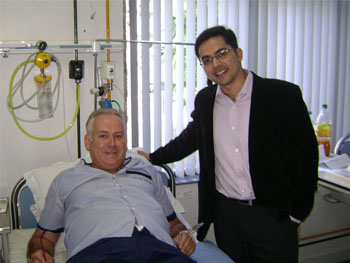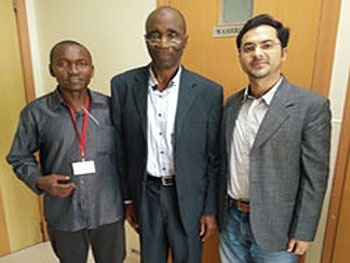Best Price Skin Cancer Treatment In India
What is the Cost of Skin Cancer Treatment with Top Hospitals and Top Surgeons in India?
- The average cost of the Skin Cancer Treatment is very high in western countries.
- India is known worldwide for its advanced medical facilities and promising technology for Skin Cancer Treatment. Many of the best hospitals for Skin Cancer Treatment can be found in India.
- Skin Cancer Treatment cost in India is much less when compared to any other countries. Also the cost of Skin Cancer Treatment in India is substantially lower than other developed countries of the world.
- The average cost of Skin Cancer Treatment in India approximately Rs. 2,10,000 ($2,600) to 4,20,000 ($5,200).
Various deciding factors could determine the price of Skin Cancer Treatment in India. These can be broadly classified as Hospital, Medical Team or Patient Dependent factors.
Hospital Factors
- Type of the hospital (Government/Trust/Private).
- Use of insurance, type of insurance or self paid.
- Accreditation of the facility
- Reputation and brand value of the hospital.
Medical Team Factors
- Technology / Approach Used
- Surgery Type
- Type of Anesthesia or Sedation
- Qualification / Expertise of the specialist
- Extent of the surgery needed
Patient Factors
- Patient’s diagnosis
- Patient’s general health
- Room Category selected by the patient
- Other treatment required by the patient in conjunction
The LIST of AVERAGE COST of the Skin Cancer Treatment across TOP 15 cities in India in Indian Rupee (INR) is as follows –
| City | Lowest Cost | Average Cost | Highest Cost |
|---|---|---|---|
| New Delhi | 1,90,000 | 2,65,000 | 3,40,000 |
| Mumbai | 2,00,000 | 2,75,000 | 3,50,000 |
| Chennai | 2,25,000 | 3,00,000 | 3,75,000 |
| Bangalore | 2,10,000 | 2,90,000 | 3,60,000 |
| Hyderabad | 2,50,000 | 3,25,000 | 4,00,000 |
| Ahmedabad | 2,75,000 | 3,50,000 | 4,25,000 |
| Nagpur | 1,75,000 | 2,50,000 | 3,25,000 |
| Pune | 2,00,000 | 2,75,000 | 3,50,000 |
| Gurgoan / Gurugram | 1,90,000 | 2,65,000 | 3,40,000 |
| Kolkata | 2,75,000 | 3,50,000 | 4,25,000 |
| Chandigarh | 2,00,000 | 2,75,000 | 3,50,000 |
| Jaipur | 2,50,000 | 3,25,000 | 4,00,000 |
| Noida | 1,90,000 | 2,65,000 | 3,40,000 |
| Kerala | 2,75,000 | 3,50,000 | 4,25,000 |
| Goa | 2,50,000 | 3,25,000 | 4,00,000 |
Our Hospitals Network and Surgery Group are available in 15 cities of India for our patients to access. Kindly fill up the form for a free opinion from our expert team. We shall get you a Free, No Obligation Opinion from India's best Surgeons and best Hospitals in India. NO CHARGES LEVIED
Special ALL SERVICES INCLUSIVE Packages available for INTERNATIONAL PATIENTS
Post a QueryIntroduction
Skin cancer is a common and locally destructive cancerous growth of the skin. It originates from the cells which line up along the membrane which separate the superficial layer of the skin from the deeper layers. Unlike the cutaneous malignant melanoma, the vast majority of these sorts of skin cancers have a limited potential to metastasize and become life threatening.
Over 5.4 million cases of non-melanoma skin cancer are treated in over 3.3 million people, skin cancer statistics contributes 65%-75% of skin cancers in whites and 20%-30% in Asian Indians and a majority of skin cancer patients travel to for Melanoma Skin Cancer Treatment in India.
Types of Skin Cancer
- Actinic Keratoses (AK): The dry, scaly patches or spots are precancerous growths. People with fair skin get AKs and most of them after 40 years of age. This is because the AKs tend to develop after years of sun exposure. Usually, they form on the skin which gets lots of sun exposure such as the head, hands, neck and forearms. Treatment is important since an AK progress to a type of skin cancer called squamous cell carcinoma (SCC).
- Basal Cell Carcinoma (BCC): The most common type of skin cancer that develops frequently in people with fair skin yet can also occur in people with dark skin. It looks like a flesh-colored, pearl-like bump or a pinkish patch of skin which develop after years of frequent sun-exposure or indoor tanning. They are more common on the head, neck, arms and can form anywhere on the body including the abdomen, chest and legs. Early diagnosis and treatment for BCC is vital as it can invade the surrounding tissue and grow into the bones and nerves therefore cause damage and disfigurement.
- Squamous Cell Carcinoma (SCC): It is the second most common type of skin cancer which is most likely to develop in people with light skin, yet they can develop in darker-skinned people. Often it looks like a red firm bump, scaly patch or a sore which heals and then re-opens. It tends to form on skin which gets frequent sun exposure such as the rim of the face, ear, neck, chest, back and arms. It can also grow deep in the skin and cause damage and disfigurement. Early diagnosis and treatment prevent this and stop it from metastasizing.
- Melanoma: It is the deadliest form of skin cancer which frequently develops in a mole or suddenly appears as a new dark spot on the skin. Early diagnosis and treatments are important. Knowing the warning signs of melanoma can help you find an early melanoma.
Risk Factors
Most common risk factors for skin cancer are:
- Sun burns early in life and exposure to sunlight, especially UV-B rays from tanning beds
- A chronically suppressed immune system from underlying diseases such as HIV/AIDS infection or cancer or some medications such as chemotherapy or prednisone
- Patients with previously diagnosed melanoma are at increased risk, around 5-10% will develop a second primary
- Exposure to ionizing radiation (X-rays) or chemicals that are known to predispose to cancer such as arsenic.
- Genetics may play a role- patients with at least one affected first degree relative possess a higher likelihood to develop malignant melanoma.
- Certain types of sexually acquired wart virus infections
- Elderly patients have more skin cancers
Symptoms
Most BCC have few if any symptoms while SCC may be painful. Both forms of skin cancer may appear as a sore which oozes, bleeds, crusts or otherwise will not heal. They start as a slowly growing bump on the skin which may bleed after minor trauma. Both skin cancer types may have raised edges and a central ulceration.
- Symptoms of BCC include:
- Pink skin growths or lesions with raised borders which are crusted in the center
- Appearance of a shiny pink, pearly, red or translucent bump
- A white, yellow or waxy area with a poorly defined border which may resemble a scar
- Raised reddish patch of skin which may crust or itch but usually it is not painful
- Symptoms of SCC include:
- Open sore which does not go away for weeks
- Persistent, scaly red patches with irregular borders which may easily bleed
- A wart-like growth
- A raised growth with a rough surface which is indented in the middle
Diagnosis
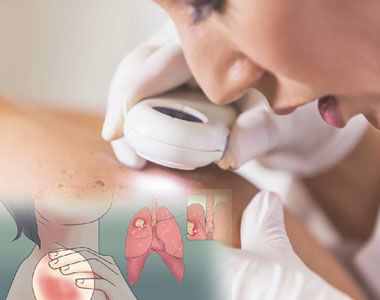 As per the American Cancer Society, ABCDEs serve a simple guideline of early melanoma warning signs. It should be suspected in any skin lesion with is Asymmetric, has an irregular Border, which is variegated or dark in Color, has a larger than 6mm in Diameter or that is elevated.
As per the American Cancer Society, ABCDEs serve a simple guideline of early melanoma warning signs. It should be suspected in any skin lesion with is Asymmetric, has an irregular Border, which is variegated or dark in Color, has a larger than 6mm in Diameter or that is elevated.
A skin examination by a dermatologist is the best way to get a definitive diagnosis of skin cancer. In most cases, the appearance alone is sufficient to make the diagnosis. Usually a skin biopsy is used to confirm a suspicion of the skin cancer. This is done by numbing the area under the tumor with a local anesthetic such as lidocaine and a small portion of the tumor is sliced away and sent for examination by a pathologist, who will look at the tissue under a microscope to render a diagnosis based on its characteristics.
Staging
The stage of a cancer tells you how big it is and if it has spread. This will help the doctor to decide which treatment you need. Your doctor will carry out a number of tests to stage your cancer. Most BCC don’t need staging since it’s very rare for them to spread. They will be stages only if they are large. Staging is more likely for SCC as they can spread, although it is still rare. Doctors can use the TNM (Tumor, Node, Metastases) system to stage your cancer.
- Stage 0: Also called Bowen’s disease or carcinoma in situ. The cells have started to turn into cancer but not yet spread or grown into surrounding areas of the skin. If not treated, Bowen’s disease might develop into SCC. Hence, your doctor may describe this stage as pre cancerous or pre malignant.
- Stage 1: The cancer is 2cm across or less and has 1 or no high risk features. The high risk features mean the cancer is more than 2mm thick, has grown in the lower dermis, into the space around a nerve, started on the ear or lip and looks very abnormal under the microscope.
- Stage 2: The cancer is more than 2cm across or has two or more high risk features.
- Stage 3: The cancer has either grown into the bones in the face such as the bone around the eye, the jaw bone or spread to a nearby lymph node on the same side of the body which is less than 3cm.
- Stage 4: The cancer has either grown into the ribs, spine, or lower part of the skull or grown to a lymph node which is more than 3cm or to an internal organ such as the lungs.
- 5000 PATIENTS TREATED IN LAST 15 YEARS FOR COMPLEX CANCER SURGERY AND ONCOLOGY MANAGEMENT
- TELE CONSULTING AND MEDICAL CONSULT TIE UPS PRESENT IN 15 MAJOR CITIES OF AFRICA AND 6 MAJOR CITIES OF MIDDLE EAST
- CANCER SURGERY FELLOWSHIPS AND TRAINING PROGRAMS AVAILABLE FOR SURGEONS FROM OTHER COUNTRIES
Phone Numbers Reach Us -
India & International : +91 9371770341
Conditions
Skin cancer will be treated by a dermatologist. You may also see an oncologist or a cancer specialist. If you have surgical removal of a tumor, depending on how much skin is removed you may see a plastic or a reconstructive surgeon after the tumour removal help to restore the appearance of the skin on the face.
There are several Types of skin cancer Treatment in India. The choice of therapy depends on the size and location of the tumor, the microscopic characteristics of the cancer and the general health of the patient.
Topical medications : In case of superficial BCCs, some gels, creams and solutions can be used which works by stimulating the body’s immune system, causing it to produce interferon which attacks the cancer and fluorouracil (5-FU), a chemotherapy drug.
Some patients do not experience any side effects but others may have inflammation, redness, and irritation. A drawback is that there is no tissue left to examine if a tumor has been removed completely.
Destruction by electrodessication and curettage (EDC) : The tumor area is numbed with a local anesthetic and repeatedly scraped with a sharp instrument, curette and the edge is then cauterized with an electric needle. Advantage is that it is easy, fast and relatively inexpensive. Disadvantages are that the scar is somewhat unsightly and the recurrence rate is as high as 15%.
 Surgical excision : The area around the tumor is numbed with a local anesthetic. A football-shaped portion of the tissue including the tumor is removed and then the wound edges are closed with sutures. Skin grafts or flaps are needed to close the defect for the very big tumors. Advantages are that there is a greater than 90% cure rate; the surgical specimen can be examined to ensure that the whole tumor has been removed successfully and the scar produced is often more cosmetically acceptable than that of the EDC procedure. This is a more complicated and expensive procedure than an EDC.
Surgical excision : The area around the tumor is numbed with a local anesthetic. A football-shaped portion of the tissue including the tumor is removed and then the wound edges are closed with sutures. Skin grafts or flaps are needed to close the defect for the very big tumors. Advantages are that there is a greater than 90% cure rate; the surgical specimen can be examined to ensure that the whole tumor has been removed successfully and the scar produced is often more cosmetically acceptable than that of the EDC procedure. This is a more complicated and expensive procedure than an EDC.
Mohs micrographic surgery : The site is locally anesthetized and the surgeon removes the visible tumor with a small margin of the normal tissue. This will be immediately evaluated under a microscope and areas which demonstrate residual microscope tumor involvement which are re-excised and the margins are re-examined. This cycle will continue until no further tumor is seen. It is a more complicated and expensive option for treating tumors where normal tissue preservation is vital, where the tumor margins are poorly defined and in tumors which have been treated previously and have recurred and in certain high-risk tumors.
Radiation Therapy : About ten to fifteen treatment sessions will deliver a high dose of radiation to the tumor and a small surrounding skin area. It is useful for those who are not candidates for any surgical procedure. Advantage is that there is no cutting involved. Disadvantage of this expensive alternative is that the treated area cannot be tested to ensure that the whole tumor is gone and the radiation scars may look worse over time. Hence it is usually reserved for the elderly patients.
Other types of skin cancer treatments include photodynamic therapy (PDT) in which medication and blue light is used to destroy the cancerous tissue, cryosurgery where the tissue is destroyed by freezing, laser surgery to vaporize or ablate the skin’s top layer and destroy lesions and oral medications.
Follow-up Care
It is vital to check your skin and know how to protect it in the sun. Contact your GP or specialist, if you spot any signs of another skin cancer between checkups.
Ms. Gracy Wyatt from Canada sharing her Experience of getting Skin Cancer Treatment in India
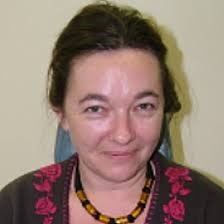
Ms. Gracy Wyatt from Canada
As a mother with a then 5 year old girl who rarely understood what cancer even means, I was really worried that she won’t be able to handle the stressful environment of the hospital and it will become very exhausting for my husband to manage the finances, work, kid and my treatment all at the same time. But the moment I entered the hospital for my skin cancer treatment in India, half of my worried vanished looking at the way the staff treated the patients and their families. My daughter and I were made to feel so much at ease that I did not even realize how the treatment and recovery days went by and all the credit for this goes to Indian Cancer Surgery Group.
Top 10 Skin Cancer Surgeons in India
- DR. VINOD RAINA
- DR. (COL.) R RANGA RAO
- DR. ARCHIT PANDIT
- DR M A RAJA
- DR. RANGARAJU RANGA RAO
- DR. AMIT AGARWAL
- DR. RAJESH MISTRY
- DR. MANISH JOSHI
- DR. SANJAY SINGH NEGI
- DR. SUDHIR TOMEY
- DR. BALA CHANDRAN TG
- DR. MANDEEP SINGH
- DR. PARITOSH S GUPTA
- DR. HARIT CHATURVEDI
- DR. ASHOK VAID
- DR. DURGATOSH PANDEY
- DR.HARI GOYAL
- DR. MEENU WALIA
- DR. S HUKKU
- DR. RAJESH JINDAL
Top 10 Skin Cancer Hospitals in India
- MEDANTA- THE MEDICITY, GURGAON
- BLK SUPER SPECIALITY HOSPITAL, NEW DELHI
- MAX SUPER SPECIALTY HOSPITAL NEW DELHI
- INDRAPRASTHA APOLLO HOSPITAL NEW DELHI
- KOKILABEN DHIRUBHAI AMBANI HOSPITAL, MUMBAI
- JAYPEE HOSPITAL NOIDA
- FORTIS MEMORIAL RESEARCH INSTITUTE (FMRI) GURGAON
- ARTEMIS HOSPITAL, GURGAON
- HCG HOSPITALS, BANGALORE
- FORTIS HOSPTIAL, NOIDA
- FORTIS MEMORIAL RESEARCH INSTITUTE, GURGAON
- MANIPAL HOSPITAL BANGALORE
- FORTIS ESCORTS HEART INSTITUTE, NEW DELHI
- PUSHPAWATI SINGHANIA RESEARCH INSTITUTE, NEW DELHI
- NARAYANA MULTISPECIALTY HOSPITAL, BENGALURU
How many patients underwent Skin Cancer Treatment in India in the last 5 years?
- In recent years, India has emerged as a medical hub for patients looking for affordable, accessible and efficient low cost Skin Cancer Treatment.
- Some of the best Skin Cancer Treatment hospitals in the world are found in India. Squamous Cell Carcinoma Treatment Cost in India is relatively affordable with the best healthcare facilities.
- Early diagnosis, surgery or treatment helps to enhance the chances of a successful outcome with Skin Cancer Test in India at Best Hospital.
- An average increase of 15 to 20 percent annually has been observed in the number of patients in the last 5 years.
- The Indian Skin Cancer Treatment hospitals deliver advanced oncology care and highest quality services backed by elaborate infrastructure andbest price skin cancer treatment..
Here are the approximate figures of the patients underwent Skin Cancer Treatment in the last 5 years in India
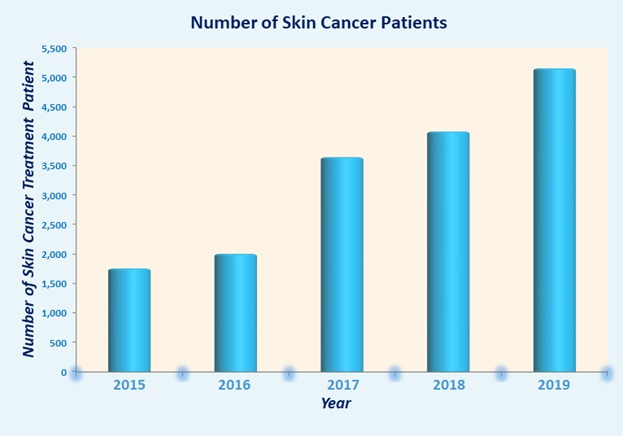
Please consult us to Get free quotes, opinions from Top Hospitals and Best Surgeons of India for Skin Cancer Treatment.
CLICK HERE to get a “No Obligation Quote”Some of the common countries from which patients travel to India for surgery are:
| United States | Bangladesh | SaudiArab |
| Iraq | UAE | South Korea |
| United Kingdom | Oman | Qatar |
| Afghanistan | Sudan | Yemen |
| Canada | Ghana | Jordan |
| France | Nepal | Singapore |
| Mauritius | Australia | Indonesia |
| Ireland | Germany | Egypt |
Our Success Stories
Mr.Richard Cooper Parson, UK
Successful Robotic Radical Prostatectomy in India
Different methodologies are tried when a person encounters cancer in the prostate...
Read More
Mr. Yukub Abbas Ebrarim , South Sudan
Success Story of Pancreatic Cancer In India
India Cancer Surgery Site has served in bulk to its patients by helping them battle against...
Read More
Mr. Charles Nige,
Africa
Breast Cancer Surgery of his Wife In India
Hi! I am Mr. Charles; I am from Africa, to be specific from Nigeria. Recently, my wife...
Read More

 English
English Arabic
Arabic French
French Bangla
Bangla Russian
Russian







